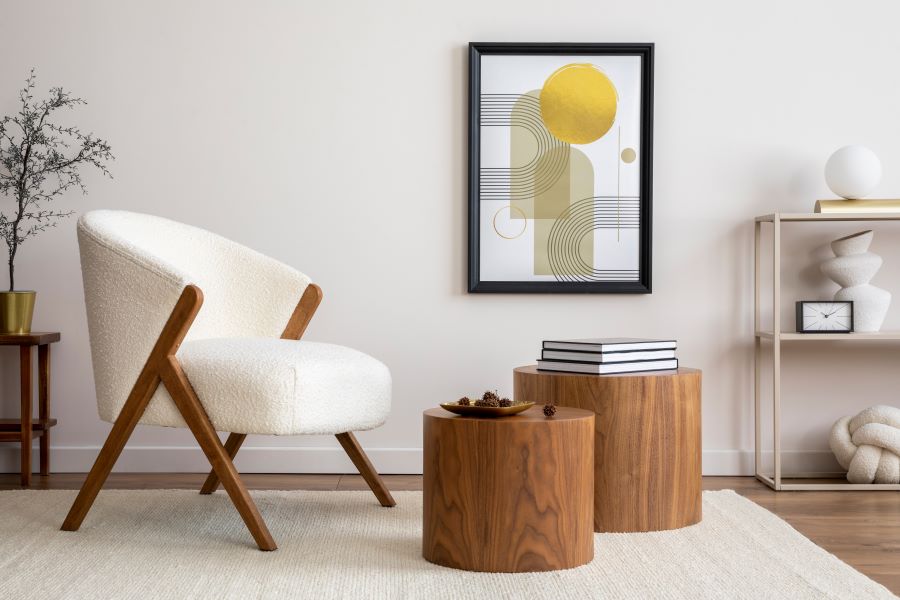Biomorphic Furniture: Nature-Inspired Forms Revolutionizing Home Design
Imagine stepping into a living room where the coffee table mimics the fluid curves of a river stone, and the sofa's organic shape recalls a gently unfurling leaf. This isn't a scene from a futuristic movie, but the latest trend in home design: biomorphic furniture. Blending the boundaries between nature and interior spaces, this innovative approach is transforming how we perceive and interact with our home environments.

The Roots of Biomorphic Design
Biomorphic design, while currently experiencing a renaissance, has its roots in the mid-20th century. Pioneered by designers like Isamu Noguchi and Eero Saarinen, this approach drew inspiration from natural forms to create furniture that was both functional and sculptural. These early adopters challenged the rigid, rectilinear designs of their time, introducing curves and organic shapes that resonated with the human form and psyche.
The concept wasn’t entirely new; Art Nouveau had already explored natural forms in decorative arts. However, biomorphic design took this further, integrating these organic shapes into the very structure and function of furniture pieces. This shift marked a significant departure from the prevailing design philosophies and laid the groundwork for the current revival we’re witnessing today.
The Science Behind the Aesthetics
Recent studies in environmental psychology have shed light on why biomorphic design resonates so deeply with us. Researchers have found that exposure to nature-inspired forms can reduce stress, improve cognitive function, and enhance overall well-being. This phenomenon, known as biophilia, suggests that humans have an innate connection to nature that can be tapped into through design.
Biomorphic furniture capitalizes on this connection by incorporating natural patterns, textures, and shapes. The gentle curves and organic lines mimic those found in nature, creating a subconscious sense of familiarity and comfort. This scientific backing has propelled biomorphic design from a niche aesthetic choice to a well-regarded approach in creating healthier, more harmonious living spaces.
Crafting Nature-Inspired Masterpieces
The creation of biomorphic furniture is a blend of artistry and engineering. Designers often start with natural inspiration – a leaf, a pebble, or even the human body – and translate these forms into functional pieces. Advanced 3D modeling software allows for the precise manipulation of curves and contours, while innovative manufacturing techniques like 3D printing and CNC milling make it possible to produce these complex shapes at scale.
Materials play a crucial role in biomorphic design. While traditional materials like wood and metal are still used, there’s a growing trend towards eco-friendly options that further reinforce the connection to nature. Recycled plastics, bamboo, and even mycelium (fungal threads) are being explored as sustainable alternatives that can be molded into organic forms.
Integrating Biomorphic Furniture into Modern Homes
Incorporating biomorphic furniture into existing decor schemes requires a thoughtful approach. These pieces often serve as statement items, drawing the eye and anchoring a room’s design. A sinuous, biomorphic chair can become the focal point of a living room, while a set of organically shaped side tables can add visual interest to a minimalist bedroom.
Color plays a significant role in biomorphic design. While neutral tones that evoke natural materials are popular, there’s also a trend towards bold, nature-inspired hues. Deep greens, rich browns, and vibrant blues can enhance the organic feel of biomorphic pieces while adding depth and character to a space.
Lighting is another crucial element in showcasing biomorphic furniture. Soft, diffused lighting can enhance the gentle curves and create interesting shadows, adding another layer of visual interest. Some designers are even incorporating biomorphic principles into lighting fixtures themselves, creating lamps and chandeliers that seem to grow and flow like natural organisms.
The Future of Biomorphic Design
As technology continues to advance, the possibilities for biomorphic furniture are expanding. Emerging techniques in parametric design allow for even more complex and nature-inspired forms, while advancements in materials science are enabling furniture that not only looks organic but behaves organically too.
One exciting development is the integration of smart technology into biomorphic furniture. Imagine a chair that adjusts its shape based on your posture, or a table that changes color to match your mood or the time of day. These innovations promise to create living spaces that are not just visually connected to nature, but responsive to our needs in ways that mimic natural systems.
The rise of biomorphic furniture represents more than just a passing trend; it’s a fundamental shift in how we approach interior design. By bringing the forms and rhythms of nature into our homes, we’re creating spaces that are not only beautiful but also deeply nurturing to our well-being. As we continue to grapple with the challenges of modern life, the comforting embrace of biomorphic design offers a welcome respite and a reconnection to the natural world.





